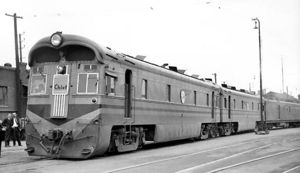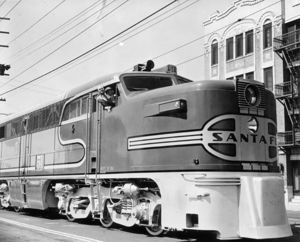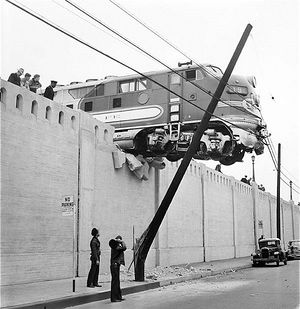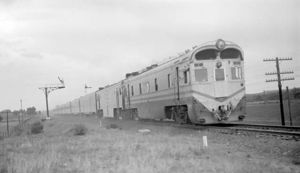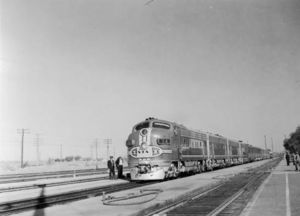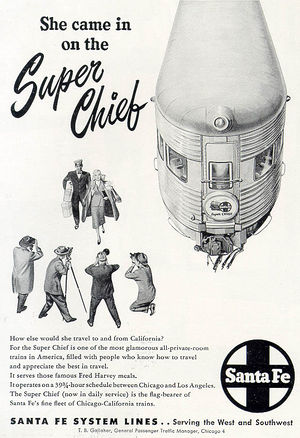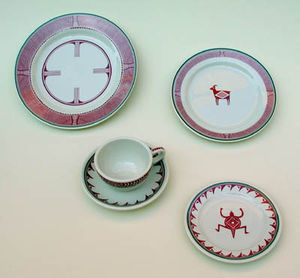Super Chief
The Super Chief was one of the named passenger trains of the Atchison, Topeka and Santa Fe Railway (AT&SF). The railroad's flagship line (owing to the high level of service and popularity), it was often referred to as "The Train of the Stars" in acknowledgement of the many celebrities who traveled on the streamliner between Chicago, Illinois and Los Angeles, California. The Super Chief (assigned train Nos. 17 & 18) was the first diesel-powered, all-Pullman sleeping car train in America, and it eclipsed the Chief as Santa Fe's standard bearer. The extra-fare Super Chief-1 commenced its maiden run from Chicago's Dearborn Station on May 12, 1936. Just over a year later, on May 18, 1937 the much-improved Super Chief-2 traversed the 2,227.3 miles (3,584.5 kilometers) from Los Angeles over recently upgraded tracks in just 39 hours and 49 minutes (averaging 60.8 miles-per-hour (98.0 km/h), often exceeding 100 miles-per-hour in the process). From that day forward the Super Chief set a new standard for luxury rail travel in America. With just the one set of equipment, the train initially operated only once a week from both Chicago and Los Angeles. However, at the height of its popularity, and with added equipment, the trains of the Super Chief made daily departures from both ends of the line. Adding to the train's mystique were its gourmet meals and Hollywood clientèle.
Direct competitors to the Super Chief during its lifetime included the City of Los Angeles, a streamlined passenger train jointly operated by the Chicago and North Western Railway and the Union Pacific Railroad, and (to a lesser extent) the Golden State, a streamlined passenger train jointly operated by the Rock Island and Southern Pacific railroads. Making its way through mostly sparsely populated areas (which enhanced the train's already distinctive aura), Santa Fe's route from Chicago to Los Angeles was the lengthiest of the high-speed, long distance trains of the day. The Santa Fe Super Chief was the last passenger train in the United States to carry an all-Pullman consist. The train maintained its legendary high level of service until the end of Santa Fe passenger operations on April 30, 1971. When Amtrak assumed operation of the nation's passenger service on May 1, 1971 it ended the 35-year run of the Super Chief on the Santa Fe, though the name would continue in use along the same route until 1974 when the Santa Fe forced Amtrak to drop the train's name due to a perceived decline in service. Amtrak subsequently operated the Southwest Limited over the same trackage. Following the delivery of new Superliner equipment, the Santa Fe compromised with Amtrak and the train became known as the Southwest Chief in 1984.
History
Timeline
- August 1935: General Motors Electro-Motive Division (EMD) delivers two blunt-nosed diesel-electric units Nos. 1 and 1A, which would ultimately power the Super Chief.
- September 9, 1935: Nos. 1 and 1A make their first test run under load with eight heavyweight passenger cars and a dynamometer car.
- May 12, 1936: The Santa Fe inaugurates the all-diesel powered Super Chief-1 amid much fanfare. Eleanor Powell, Hollywood's legendary dancer, christens it "The Train of the Stars."
- May 10, 1937: The last of four "preview" runs of the Super Chief-2, which utilizes an improved 3,600 hp (2.7 MW), two-unit, streamlined diesel locomotive set built by EMD as motive power, concludes as the train pulls into Union Station in Los Angeles. All heavyweight wood cars used on the Super Chief are replaced with lightweight stainless steel cars. The general public is invited to tour the new train at Santa Fe's La Grande Station on May 11th and 12th.
- May 15, 1937: The Super Chief-2 departs Los Angeles at 7:30 p.m. PST. The train completes its maiden run in just 36 hours and 49 minutes (2 hours and 56 minutes ahead of schedule), setting a new Santa Fe speed record in the process, one that would never be broken. It would subsequently be determined that both of the new E1 units suffered mechanical damage during the trip east, and they would be taken out of service for repairs.
- May 18, 1937: The Super Chief-2 commences its first regular run, led by Unit 1A and EMD demonstrator Unit 512 (a.k.a. AT&SF Unit 1C), as it departs Chicago's Dearborn Station. The passenger list includes ventriloquist Edgar Bergen and his "sidekick" Charlie McCarthy.
- January 1938: E1 Units 3 and 3A are added to the Santa Fe roster and placed into service on the Super Chief-2.
- February 26, 1938: A "borrowed" six-car Chief consist begins operating as the Super Chief-2½ due to production delays in order to provide twice-weekly service on the line.
- July 2, 1938: A second, all-lightweight trainset built by Pullman-Standard enters service as the Super Chief-3 and officially replaces the Super Chief-2½.
- 1941: The Santa Fe takes delivery of its only 2,000 hp (1.5 MW) ALCO DL-109/110 model locomotives, Units 50 and 50A respectively, which become the primary motive power for the Super Chief-3.
- July 7, 1942: The Super Chief goes on a wartime schedule of 41 hours, 45 minutes. Consist size expands to 12 cars, and each logs 636 daily miles.
- June 2, 1946: The line reverts to its prewar schedule of 39 hours and 45 minutes.
- September 29, 1946: The Super Chief begins an every-other-day departure schedule from Chicago and Los Angeles.
- January 25, 1948: Locomotive #19L, leading the Super Chief, loses braking ability while preparing to depart Los Angeles' Union Passenger Terminal (LAUPT). The train crashes through a steel bumper post and then a concrete wall located at the end of the dead-end track, and ultimately comes to rest with the front half of the locomotive dangling 20 feet (6 m) above the street below. Although there are no injuries, the engineer loses his job over the incident.
- February 29, 1948: The AT&SF receives the first post-War equipment order from Pullman-Standard and places these into service on the Super Chief. The railroad now has five Super Chief trainsets and the frequency of operation is upgraded to daily.
- December 29, 1949: Train No. 17, led by locomotive set #37L/A/B/C, collides with a tanker truck in Azusa, California. All four locomotives, baggage car #3409, and railway post office #88 are damaged by fire.
- 1950–1951: The Super Chief is re-equipped with new sleeping cars built by the Budd Company and the American Car and Foundry Company (ACF), and dining cars from Pullman-Standard. Santa Fe also adds the Pullman-built "Pleasure Dome"-Lounge car (one of the most luxurious ever made for any train) to its Super Chief consists, billing it as the "...only dome car between Chicago and Los Angeles." A speedometer located in the front of the car allowed passengers to monitor the train's velocity.
- June 1952: The Super Chief is prominently featured in the Warner Bros. film Three for Bedroom C starring Gloria Swanson.
- 1954: The General Tire and Rubber Company utilizes the Super Chief as the centerpiece of a print advertisement for its new "Nygen Cord" tire, in which the train is towed by an AT&SF switcher utilizing one of the tires as a connecting link.
- January 10, 1954: The $15.00 extra-fare charge is reduced to $7.50; the barbershop, shower-bath, and coast-to-coast Pullman (which ran through to New York by way of The Broadway Limited and the 20th Century Limited) are all discontinued.
- 1956: Santa Fe transfers Transcontinental Sleeping Car Service to the Chief. Round-end observation cars are removed from Super Chief service, converted to blunt-ended cars at Pullman's Calumet, Illinois shops, and returned to train Nos. 17 and 18. In early 1958 they are permanently removed from Super Chief service.
- Jauary 12, 1957: The Super Chief and El Capitan are combined into one train during the off-peak travel season on a 39½-hour schedule.
- 1958]]: All five Super Chief trainsets are refurbished and redecorated.
- August 21, 1964: A rail from a passing train "spears" coach #2804 in Kingman, Arizona.
- January 6, 1969: Locomotives #46L, #39C, #310B, #45B, and #44A derail due to unknown causes in Holcomb, Kansas. Cars #2924, #2866, #1563, #539, #713, #714, #650, #578, #712, #716, #707, and #526 leave the tracks as well.
- May 1, 1971: Amtrak is formed and takes over operation of the nation's passenger service, thus ending 35 years of the Santa Fe Super Chief. Amtrak retains the use of the Super Chief / El Cap names, with the Santa Fe's concurrence.
- 1973: Amtrak drops the El Capitan designation.
- March 7, 1974: The Santa Fe directs Amtrak to discontinue use of the names Super Chief (which then becomes the Southwest Limited) and Texas Chief (which is renamed the Lone Star) due to a perceived reduction in the quality of service provided on the routes.
- November 30, 1980: Amtrak's "Superliners" replace the "Pleasure Dome" and "Hi-Level" cars on the Southwest Limited.
- October 28, 1984: Due to improvements in service, the Santa Fe allows Amtrak to change the name of the Southwest Limited to the Southwest Chief.
- August 26, 1999: The United States Postal Service issues 33-cent All Aboard! 20th Century American Trains commemorative stamps featuring five celebrated American passenger trains from the 1930s and 1940s. One of the five stamps features an image of EMD E1 Unit No. 6 adorned in the Super Chief's "warbonnet" livery.
Equipment used
The first motive power set on Super Chief-1 consisted of a pair of blunt-nosed, diesel-electric units (EMD 1800 hp B-B) designated as Nos. 1 and 1A. Santa Fe employees quickly hung the nicknames "One-Spot Twins" and "Amos & Andy" (from the popular radio show of the day) on the units, which were always paired and ran back-to-back. In a little over a year the EMD E1, a new and improved 3,600 hp (2.7 MW) streamlined diesel-electric locomotive set (one hood unit and the other a cabless booster unit) would be pulling Super Chief consists. A variety of state-of-the-art locomotives (including ALCO PAs, EMD E6s, EMD FTs, EMD F3s, EMD F7s, and EMD FP45s, along with Santa Fe's only ALCO DL-109/ALCO DL-110 combo and FM Erie-built units) would make their appearances on the line in the succeeding years. All wore the now-familiar Warbonnet paint scheme devised by Leland Knickerbocker of the General Motors "Art and Color Section" that debuted on the Super Chief-2.
The Super Chief-1's mostly-heavyweight original consist included:
- EMD "Boxcab" Diesel Locomotive #1
- EMD "Boxcab" Diesel Locomotive #1A
- Baggage-Club-Lounge #1301 Chief Yellow Bear (also included a barber shop)
- Sleeper (lightweight) (8 sections, 2 compartments, 2 double bedrooms)
- Lounge General Hancock (10 sections)
- Fred Harvey Company Diner #1468 (30 seats)
- Sleeper Glen Frazer (6 compartments, 3 drawing rooms)
- Sleeper Clover Knoll (8 sections, 5 double bedrooms)
- Lounge-Observation Crystal View (3 compartments, 2 drawing rooms)
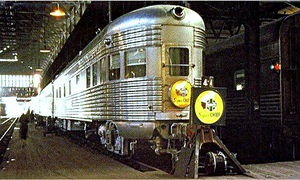
The Super Chief lays over at Chicago's Dearborn Station in 1955. Santa Fe (and other occupant railroads of the terminal) mounted drumhead-like logos on the bumper posts in Chicago's Dearborn Station; the practice continued long after the company removed observation cars from its roster.
In May, 1937 the heavyweight equipment used on the Super Chief was replaced with all lightweight stainless steel cars built by the Budd Company (the heavyweight cars were placed back in service with the Chief). For the new lightweight train (the Super Chief-2), the equipment used was as follows:
- EMD E1A Locomotive #2
- EMD E1B Locomotive #2A
- Railway Post Office-Mail Storage #3400 (transferred to the San Diegan prior to entering revenue service)
- Baggage-Mail #3430
- Sleeper Isleta (8 sections, 2 compartments, 1 drawing room)
- Sleeper Laguna (8 sections, 2 compartments, 1 drawing room)
- Dormitory-Lounge #1370 Acoma (also included a barber shop)
- Fred Harvey Company Diner #1474 Cochiti (36 seats) – now on permanent display at the California State Railroad Museum in Sacramento, California
- Sleeper Oraibi (2 compartments, 2 drawing rooms, 6 double bedrooms)
- Sleeper Taos (2 compartments, 2 drawing rooms, 6 double bedrooms)
- Sleeper-Lounge-Observation Navajo (3 compartments, 2 drawing rooms, 1 double bedroom)
The sleeping cars in this consist were operated by Pullman but were owned by the Santa Fe. The car names were chosen to commemorate the Native American tribes, pueblos, and cities found along the railroad's route.
On February 26, 1938 the consist was modified somewhat:
- EMD EMD E1A Locomotive #2
- EMD E1B Locomotive #2A
- Baggage-Dormitory-Buffet Lounge #1386 San Clemente
- Sleeper Tuba (17 roomettes)
- Sleeper Isleta (8 sections, 2 compartments, 1 drawing room)
- Sleeper Taos (2 compartments, 2 drawing rooms, 6 double bedrooms)
- Dormitory-Lounge #1370 Acoma (also included a barber shop)
- Fred Harvey Company Diner #1474 Cochiti (36 seats)
- Sleeper Oraibi (2 compartments, 2 drawing rooms, 6 double bedrooms)
- Sleeper Laguna (8 sections, 2 compartments, 1 drawing room)
- Sleeper-Lounge-Observation Navajo (3 compartments, 2 drawing rooms, 1 double bedroom)
The railroad also added another trainset (the Super Chief-2½) utilizing sleeping cars borrowed from the Chief in order to handle the high demand for passage aboard the train. Its original consist was as follows:
- EMD E1A Locomotive #3
- EMD E1B Locomotive #3A
- Baggage-Dormitory-Buffet Lounge car #1387 San Acacia
- Sleeper Chinle (17 roomettes)
- Sleeper Wupatki (8 sections, 2 compartments, 2 double bedrooms)
- Sleeper Klethla (4 compartments, 2 drawing rooms, 4 double bedrooms)
- Dormitory-Lounge #1377 Agathla (also included a barber shop)
- Fred Harvey Company Diner #1485 Awatobi (36 seats)
- Sleeper Polacca (4 compartments, 2 drawing rooms, 4 double bedrooms)
- Sleeper Yampai (8 sections, 2 compartments, 2 double bedrooms)
- Sleeper-Lounge-Observation Chaistla (4 drawing rooms, 1 double bedroom)
On July 2 of that year the permanent Super Chief-3 consist was established:
- EMD E1A Locomotive #3
- EMD E1B Locomotive #3A
- Baggage-Dormitory-Buffet-Lounge #1387 San Acacia
- Sleeper Chimayo (17 roomettes)
- Sleeper Talwiwi (8 sections, 2 compartments, 2 double bedrooms)
- Sleeper Tchirge (4 compartments, 2 drawing rooms, 4 double bedrooms)
- Dormitory-Lounge #1377 Agathla (also included a barber shop)
- Fred Harvey Company Diner #1485 Awatobi (36 seats)
- Sleeper Tsankawi (4 compartments, 2 drawing rooms, 4 double bedrooms)
- Sleeper Tyuonyi (8 sections, 2 compartments, 2 double bedrooms)
- Sleeper-Lounge-Observation Puye (4 drawing rooms, 1 double bedroom)
Beginning in 1947, a typical Super Chief consist:
- EMD EMD FTA Locomotive #163L
- EMD FTB Locomotive #163A
- EMD FTB Locomotive #163B
- EMD FTA Locomotive #163C
- Baggage-Buffet-Lounge #1384 San Ignacio (also included a barber shop)
- Sleeper Toroweap (8 sections, 2 compartments, 2 double bedrooms)
- Sleeper Tonto (17 roomettes)
- Sleeper Moencopi (4 compartments, 2 drawing rooms, 4 double bedrooms)
- Sleeper Jadito (4 compartments, 2 drawing rooms, 4 double bedrooms)
- Dormitory-Club-Lounge #1375 Moencopi
- Fred Harvey Company Diner (36 seats) #1484
- Sleeper Kietsiel (4 compartments, 2 drawing rooms, 4 double bedrooms)
- Sleeper Hualapai (4 compartments, 2 drawing rooms, 4 double bedrooms)
- Sleeper Segatoa (8 sections, 2 compartments, 2 double bedrooms)
- Sleeper-Lounge-Observation Coconino (4 drawing rooms, 1 double bedroom)
A typical Super Chief consist from 1948 to 1951:
- EMD EMD F3A Locomotive #17L
- EMD F3B Locomotive #17A
- EMD F3B Locomotive #17B
- EMD F3A Locomotive #17C
- Baggage #3446
- Baggage-Buffet-Lounge #1383 San Simon (also included a barber shop)
- Sleeper Blue Grove (10 roomettes, 2 compartments, 3 double bedrooms)*
- Sleeper Blue Point (10 roomettes, 2 compartments, 3 double bedrooms)*
- Sleeper Regal Town (4 compartments, 2 drawing rooms, 4 double bedrooms)
- Dormitory-Club-Lounge #1392
- Fred Harvey Company Diner (36 seats) #1493
- Sleeper Regal Pass (4 compartments, 2 drawing rooms, 4 double bedrooms)
- Sleeper Regal Center (4 compartments, 2 drawing rooms, 4 double bedrooms)
- Sleeper Blue Springs (10 roomettes, 2 compartments, 3 double bedrooms)*
- Lounge-Observation Vista Canyon (4 drawing rooms, 1 double bedroom)
- *NOTE: The nineteen "10-2-3" sleepers in the Blue series had a floor plan configuration unique to the Santa Fe.
In the 1940s and into the 1950s, the Super Chief occasionally interchanged sleepers with other railroads in order to provide "coast-to-coast" sleeping car service. In those instances, sleepers from eastern connections would take the place of Regal– or Pine–series cars:
- (Pine Leaf, Gem, Creek, Pass, Ring, Beach) — Baltimore and Ohio Railroad "10-6" from Washington, D.C. off the Capitol Limited via Chicago to San Diego (the longest Pullman run in the United States).
- (Pine Arroyo, Brook, Dale, Island, Cove, Fern) — New York Central "10-6" from New York off the 20th Century Limited via Chicago to L.A.
- (Regal Gate, Gulf, Arms, Creek, Town, Court) — New York Central "4-4-2" from New York off the 20th Century Limited via Chicago to L.A.
- (Regal Ruby, River, Spa, City, Inn, Ring) — Pennsylvania Railroad "4-4-2" from New York off the Broadway Limited via Chicago to L.A.
A typical Super Chief consist from 1951 to 1956:
- EMD F7A Locomotive #38L
- EMD F7B Locomotive #38A
- EMD F7B Locomotive #38B
- EMD F7A Locomotive #38C
- Baggage #3415
- Railway Post Office #83
- Baggage-Buffet-Lounge (also included a barber shop) #1385 San Pascal
- Sleeper Palm Top (10 roomettes, 6 double bedrooms)
- Sleeper Pine Arroyo (10 roomettes, 6 double bedrooms)
- Sleeper Regal Corps (4 compartments, 2 drawing rooms, 4 double bedrooms)
- "Turquoise Room"-"Pleasure Dome"-Lounge #502
- Fred Harvey Company Diner (48 seats) #605
- Dormitory-Club-Lounge Car #1343
- Sleeper Regal Hunt (4 compartments, 2 drawing rooms, 4 double bedrooms)
- Sleeper Regal Manor (4 compartments, 2 drawing rooms, 4 double bedrooms)
- Sleeper Palm Lore (10 roomettes, 6 double bedrooms)
- Sleeper-Lounge-Observation Vista Club (4 drawing rooms, 1 double bedroom)

The Atchison, Topeka and Santa Fe Railway's combined Super Chief / El Capitan pulls into Track 10 at Los Angeles' Union Passenger Terminal (LAUPT) on September 24, 1966.
A typical Super Chief consist from the early 1960s (all-Pullman section):
- EMD F7A Locomotive #303L
- EMD F7B Locomotive #303A
- EMD F7B Locomotive #19A
- EMD F7A Locomotive #44L
- Baggage #3544
- Sleeper Palm Summit (10 roomettes, 6 double bedrooms)
- Sleeper Pine Lodge (10 Roomettes, 6 double bedrooms)
- Sleeper Indian Drum (11 double bedrooms)
- Sleeper Regal Isle (4 compartments, 2 drawing rooms, 4 double bedrooms)
- "Turquoise Room"-"Pleasure Dome"-Lounge #501
- Fred Harvey Company Diner (48 seats) #606
- Sleeper Regal Crest (4 compartments, 2 drawing rooms, 4 double bedrooms)
- Sleeper Indian Pony (11 double bedrooms)
- Sleeper Palm Leaf (10 roomettes, 6 double bedrooms)
- Sleeper Pine Range (10 roomettes, 6 double bedrooms)

Santa Fe's EMD FP45s initially led the combined El Capitan / Super Chief and other passenger train consists, though some would later transfer to high-speed freight duty when the Super C hit the rails in 1968. #95 (see here in July, 2003 at the Western America Railroad Museum in Barstow, California) began life in December, 1967 as Santa Fe #105.
A typical Super Chief consist from the late 1960s (combined with El Capitan):
- EMD FP45 Locomotive #104
- EMD FP45 Locomotive #101
- Baggage #3671
- Baggage #3553
- Baggage-Dormitory "Transition Car" #3478
- Hi-Level "Chair car" / Coach (68 Seats) #549
- Hi-Level "Chair car" / Coach (72 Seats) #731
- Hi-Level Diner (80 seats) #654
- Hi-Level Lounge (88 seats) #575
- Hi-Level "Chair car" / Coach (72 Seats) #725
- Hi-Level "Chair car" / Coach (68 Seats) #542
- Sleeper Pine Cove (10 roomettes, 6 double bedrooms)
- Sleeper Indian Mesa (11 double bedrooms)
- "Turquoise Room"-"Pleasure Dome"-Lounge #504
- Fred Harvey Company Diner (48 seats) #600
- Sleeper Indian Flute (11 double bedrooms)
- Sleeper Palm Leaf (10 roomettes, 6 double bedrooms)
The "Hollywood mystique"
The world-famous Super Chief was an almost-instant success among travelers who appreciated its modern, air conditioned equipment, high amenity levels, and smooth ride, all of which lent the train a certain "snob appeal." The train was staffed with top-of-the-line crews who were ingrained with the best traditions of the railroad, and not only drew passengers from competing railroads but from other Santa Fe trains such as the Chief as well. Patrons took pleasure in the ability to "...Travel Santa Fe — all the way" to their destinations without the need to change trains, or at least railroads, en route.
The Super Chief quickly became "the" train to ride between Chicago and Los Angeles, much as New York Central's 20th Century Limited was the favored travel option of the time for the East Coast-bound. To acquaint passengers with the various points-of-interest located along the route, Santa Fe constructed a series of seven signs marking such notable features as the Continental Divide and Raton Pass. In the mid-1940s, company president Fred G. Gurley went to great lengths to solicit business from California's motion picture industry. To that end, a passenger agent was located in Hollywood specifically for the purpose of maintaining close contact with the movie studios. Furthermore, the train stopped at the Pasadena station solely for the purpose of allowing celebrities the opportunity to board or disembark away from the "hustle and bustle" of Los Angeles' Union Passenger Terminal (LAUPT). When the Santa Fe was notified that a particular celebrity was going to be traveling on board the Super Chief, a press release was issued to allow the media the opportunity to interview and photograph the star.
In time, the passenger list would resemble a veritable "who's who" of Hollywood stars: Richard Burton and Elizabeth Taylor, Humphrey Bogart and Lauren Bacall, Dean Martin and Jerry Lewis, Desi Arnaz and Lucille Ball, James Cagney, Judy Garland, and Bing Crosby (to name but a few) all rode the Super Chief. The train's appeal was not limited to those in the entertainment industry, though, as it also played host to Ronald Reagan, former presidents Harry S. Truman and Dwight D. Eisenhower, and their wives.
Three for Bedroom "C"
In June, 1952, Warner Bros. Pictures released Three for Bedroom "C", a romantic comedy starring Gloria Swanson, James Warren, Fred Clark, Hans Conried, and Steve Brodie. In the film, an aging movie star (Swanson) hides out in a compartment during a cross-country journey from New York to Los Angeles aboard the Super Chief. Swanson's first color film also bears the distinction of being one of very few to be shot entirely aboard actual railroad equipment. Santa Fe transported actual passenger cars from the Super Chief to the production company's studio lot for filming. The film met with lukewarm reviews and was not, as had been hoped, a financial success. It did, however, nicely showcase the many features of the Super Chief, which many train buffs feel is the real star of the motion picture.
Honeymoon and Murder on the Super Chief
In a short story written by Woodrow W. Walker, former movie stuntman turned private detective Buck Ames marries his stuntwoman girlfriend Helen Davis. They board the Super Chief for their honeymoon and encounter a murder.
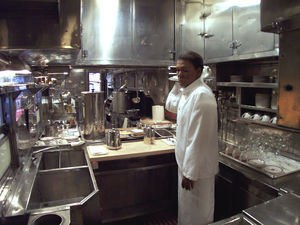
The cramped, yet efficient galley aboard the former Atchison, Topeka and Santa Fe Railway dining car #1474, the "Cochiti." The car (now restored to its mid-1940s condition) made its debut as a part of the road's Super Chief-2 inaugural consist.
Dining aboard the Super Chief
Most railroads began offering some form of meal service on their trains as an alternate to the poor fare typically found at trackside establishments even before the completion of the First Transcontinental Railroad. By the mid-1880s, dedicated dining cars were a normal part of all long-distance train consists departing from Chicago for points west, save for those of the Santa Fe, who relied on America's first interstate network of restaurants to feed its passengers en route. The legendary "Harvey Houses," located strategically along the line, served top-quality meals to railroad patrons during water stops and other planned layovers and were favored over in-transit facilities for all trains operating west of Kansas City. The Super Chief included dining cars, staffed by Fred Harvey Company personnel, as part of its standard consist from the outset. In general, the Super Chief operated 36-seat dining cars, although most of them were convertible to 48-seat dining cars with a flip-top (or change of) table and addition of chairs. Dining cars almost always operated with a lounge car coupled to them for bar-lounge service and a waiting area when the dining car was full. Unlike the Union Pacific "City" trains, the Super Chief and other Santa Fe trains did not use the "twin-unit" dining cars. Santa Fe, in general, ran somewhat shorter trains that could be serviced with a single dining car (although the heavyweight trains frequently operated in several sections, the streamlined trains generally did not). The height of Super Chief lounge and dining facilities came in 1951 with the new 600-series Dining Cars bracketed by the 500 series Pleasure Domes in front and a bar-lounge-dormitory unit in back (moved from the front of the trains). The train still operated with the Vista-series 4 Drawing Room, 1 double bedroom observation cars on the rear, albeit without any bar or buffet service.
The bar-lounge cars next to the diner always included dormitory space for the train crew (a staff of 3-4 cooks and 6-7 stewards) required for the two-night and one day trip. The eight Pullmans on the train had a capacity of between 150 and 200 passengers when full but often ran with single occupancy rooms, making the passenger load less. When Santa Fe rolled out its new "Pleasure Dome"-Lounge cars in 1951, the railroad introduced the traveling public to the Turquoise Room, promoted as "The only private dining room in the world on rails." The room accommodated 12 guests, and could be reserved anytime for private dinner or cocktail parties, or other special functions. The room was often used by the era's celebrities and dignitaries while traveling on the Super Chief. As was the case on other railroads, dining car service proved to be a losing proposition financially. Santa Fe, more than any of its competitors, took the concept of using onboard meal service as a "loss leader" to the highest level in order to attract and retain customers. Consequently, the name Super Chief became synonymous with the finest fare available on wheels.
Menu
The Continental cuisine offered aboard the Super Chief went beyond the typical American fare found on other trains, and often rivaled that served in many five-star restaurants, befitting the train's upscale clientele. A "Wake-Up Cup" of coffee was brought to one's private bedroom each morning, on request, a service exclusive to the Super Chief. Breakfast and lunch were served à la carte, while dinner could be ordered either à la carte or table d'hôte. The elaborate dinner offerings generally included caviar and other gourmet delicacies, cold salads, grilled and sauteéd fish, sirloin steaks and filet mignon, lamb chops, and the like. For the truly discerning palates, elegant champagne dinners were also an option. Ironically, one of the Super Chief's most popular signature dishes was the AT&SF version of pain perdue, simply and appropriately named Santa Fe French Toast.
Mimbreño china
The decor, linens, and other dining car accoutrements reflected the same Southwestern flair that was prevalent throughout the rest of the train. Mary Colter (architect, Indian art expert, and 35-year veteran of the Fred Harvey Company) designed the china and silverware used on the Super Chief. Colter, who also designed the interiors of Fred Harvey’s opulent La Fonda, La Posada, and El Tovar hotels, based her dinnerware motif on the Native American pictographs of animals and geometric patterns left behind on clay pots by the ancient inhabitants of the Rio Mimbres Valley in southwestern New Mexico, around 1100 A.D. The "Mimbreño" pattern was produced between 1936 and 1970 by the Onondaga Pottery Co. of Syracuse, New York under its better-known trade name, Syracuse China. The bottoms carried the inscription "Made expressly for Santa Fe Dining Car Service." These distinctive pieces made their debut on the dining car Cochiti in 1937. Used on the Super Chief and other named trains until the end of Santa Fe passenger service in 1971, original Mimbreño dinnerware can still be found today in service on BNSF Railway business cars. Mimbreño has been dubbed "the oldest of all railroad china" as its design concept dates back nearly ten centuries. Demand for surviving original pieces has created a substantial collector's market, and led to the issuance of authorized reproductions in recent years.


